七年级上册unit3topic3导学案交
七年级英语仁爱版上册Unit3_Topic3_课时同步练(解析版)_

Unit3 Topic3 课时同步练一、基础巩固Ⅰ.单项选择。
1. —Help yourselves, kids!—______A. Me, too.B. Thank you.C. All right.D. That’s OK.【解析】B Help yourself/yourselves(to sth.)!常用在招待客人时,表示“请随便(吃/喝点……)”。
其答语为“Thank you./Thanks.”,故选B。
2. —Would you like ____ bananas?—Yes, please.A. a lotB. muchC. someD. lot【解析】C some一般用于肯定陈述句中,也常用于提建议或希望得到肯定回答的疑问句中;much接不可数名词;a lot修饰动词或形容词比较级,故选C。
3. —What would you like ____?—Some milk, please.A. eatB. to eatC. drinkD. to drink【解析】D would like接名词或动词不定式,由答语“some milk, please.”可知上句问的是想喝什么,故选D。
4. —What about some ____?—Good idea!A. apple juiceB. apple juicesC. apples juiceD. apples juices【解析】A juice是不可数名词,没有复数形式;apple修饰juice时用单数形式,故选A。
5. —What do you have ____ lunch?—I often have chicken ____vegetables.A. for; inB. for; withC. to; andD. to; of【解析】B have sth. for breakfast/lunch/dinner,表示“早餐/午餐/晚餐吃……”;介词with此处表示“带有……”,故选B。
仁爱版初中英语七年级上册全册导学案(75页)
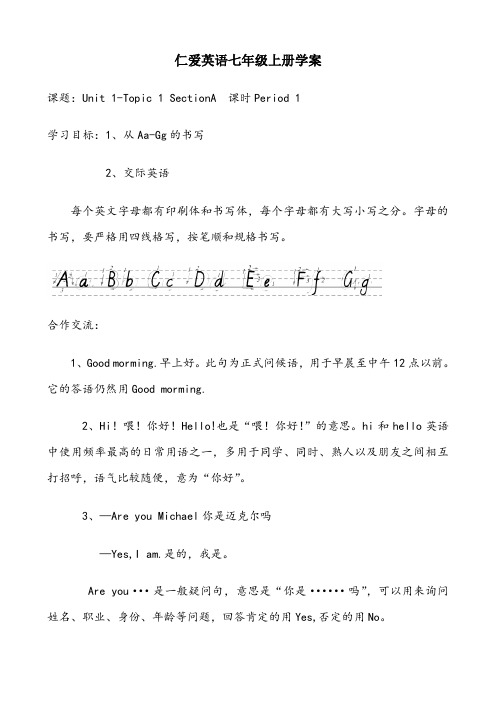
仁爱英语七年级上册学案课题:Unit 1-Topic 1 SectionA 课时Period 1学习目标:1、从Aa-Gg的书写2、交际英语每个英文字母都有印刷体和书写体,每个字母都有大写小写之分。
字母的书写,要严格用四线格写,按笔顺和规格书写。
合作交流:1、Good morming.早上好。
此句为正式问候语,用于早晨至中午12点以前。
它的答语仍然用Good morming.2、Hi!喂!你好!Hello!也是“喂!你好!”的意思。
hi和hello英语中使用频率最高的日常用语之一,多用于同学、同时、熟人以及朋友之间相互打招呼,语气比较随便,意为“你好”。
3、—Are you Michael你是迈克尔吗—Yes,I am.是的,我是。
Are you···是一般疑问句,意思是“你是······吗”,可以用来询问姓名、职业、身份、年龄等问题,回答肯定的用Yes,否定的用No。
4、—Welcome to China!欢迎到中国来!—Thank you!谢谢。
welcome to+地点名词欢迎到······来。
习题巩固:Ⅰ、按照四线格要求写出Aa-Gg。
Ⅱ、单项选择。
()1、— you Li Ping—Yes,I .;am ;am C. Are;are ;am( )2、—Nice to meet you,too.,thank you. B. Thank you C. Yes,I am. D. Nice to meet you.( )3、—Are you Li Weikang—A. Yes,I’m.B. No,I’m.C. Yes,I am.D. No,Iam.( )4、—Hi,Jane—A. Maria,hi.B. Kangkang,hi.C. Good morning .D. Hi,Michael.( )5、——Thanks.A. Nice to meet you.B. Good morning.C. Yes,I am.D. Welcome to Beijing Ren’ai International(国际的)School!Ⅲ、从Ⅱ栏选出对应的答语。
仁爱版七年级上册英语教学设计:Unit3Topic3SectionD

4.观看英语动画短片,注意其中出现的一般现在时的句子,尝试模仿并运用到自己的口语表达中。
5.每位学生选取一个体育项目,用英文撰写一篇短文,介绍该项目的基本规则、技巧和自己的体验,不少于80词。
6.小组合作,制作一份关于本节课话题的海报,要求设计新颖,内容丰富,包含一般现在时的句子和重点词汇。
3.教师通过示例、模仿、替换等教学手段,让学生掌握并运用新学的词汇和句型。
4.教师邀请学生上台进行角色扮演,展示对话内容,以提高学生的口语表达能力。
(三)学生小组讨论
1.教师将学生分成若干小组,每组选定一个小组长,确保小组活动有序进行。
2.教师给出讨论话题:“Talk about your hobbies and daily activities.”,要求学生用一般现在时描述自己的兴趣爱好和日常活动。
仁爱版七年级上册英语教学设计:Unit3Topic3SectionD
一、教学目标
(一)知识与技能
1.掌握本节课的重点词汇和短语,如:sports, swimming, basketball, football, tennis, play, like, dislike, hobby, every day等,并能熟练运用这些词汇进行交流。
3.分层次教学:针对学生的不同英语水平,设计难易程度不同的教学活动。对于基础较弱的学生,重点辅导他们掌握一般现在时的基本句型;对于基础较好的学生,则引导他们运用更多词汇和复杂句型进行表达。
4.听力训练:通过播放不同口音的听力材料,提高学生对英语语音的适应能力。在听力训练过程中,注重引导学生关注关键信息,培养他们的听力技巧。
三、教学重难点和教学设想
七年级英语上册 Unit3 Topic3(What would you li

欠风丹州匀乌凤市新城学校Unit 3 Getting TogetherTopic 3 What would you like to drink?笔试局部〔总分值100分〕I.词组互译〔10分〕1.一杯桔汁 _______________2.一些牛奶 ______________3.两袋大米_______________4.五片面包________________5.一篮子梨_______________6. something to drink____________7. four cups of water__________8. would like to go _____________9. help yourself______________10. a bowl of rice _______________II.选择题〔15分〕( ) 1. I’d like .A. a bottle of orangesB. a bottle of orangeC. a bottle of an orangeD. a bottle orange( )2. —Would you like some milk?— .A. Yes, pleaseB. Yes, I’d likeC. No, pleaseD. Yes, I’d like to( )3. Would you like something ?A. drinkB. drinkingC. to drinkD. drinks( )4. I would like to eat .A. some meatsB. some riceC. some cakeD. some breads ( )5.Would you like apples?A. anyB. someC. manyD. am( )6. There are on the table.A. a glass of waterB. a glass of milkC. two glasses of waterD. a glass of orange( )7. Look! Some meat in the box. Some apples in the basket.A. is, isB. are, areC. is, areD. are, is ( )8. What would you like supper?A. atB. toC. inD. for( )9. What do you think the coffee?A. onB. ofC. inD. at( )10. Chinese people are very .A. friendB. friendlyC. friendsD. friends ( )11. there any meat on the table?A. IsB. AreC. HaveD. Has( )12. I have no pears now. What apples?A. isB. aboutC. areD. does ( )13. Why have some noodles?A. don’tB. isn’tC. notD. /( )14. I’m thirsty〔口渴〕.I want to something.A. eatB. drinkC. takeD. know ( )15. Help to some meat, Lucy.A. youB. yoursC. yourselvesD. yourself III.改错。
Unit 3Topic 3 知识梳理 仁爱版英语七年级上册

Unit 3 Topic 3 知识梳理一.重点单词yourself(pron.)——yourselves(pl.) △usually(adv.)——usual(adj.)would(modal v.过去式)——will(原形) △kind(adj.)——kindness(n.)二.词组Section A1.help yourself 请你随便吃2.help yourselves 请你们随便吃3.would like sth=’d like sth 想要某物4.would like to do 想要做某事5.would like to eat/drink/have 想要吃/喝/吃(喝)6.some fish/chicken/rice/bread/water/milk/juice 一些鱼肉/鸡肉/米饭/面包/水/牛奶/果汁7.some vegetables/hamburgers 一些蔬菜/几块汉堡包8.all right=OK 好吧Section B1.have...for breakfast/lunch/dinner 早饭吃.../午饭吃.../晚饭吃...2.chicken with vegetables 带蔬菜的鸡肉3.Chinese food 中国菜4.take your order 记下你点的菜5.something to drink/eat 一些喝的/吃的东西6. a glass of apple juice 一杯苹果汁Section C1.eat out 出去吃饭2.have breakfast/lunch/dinner with me 和我吃早饭/午饭/晚饭3.what about=how about 怎么样4.why not +动词原形为什么不Section D1.be kind to sb. 对某人友好三.知识点解析Section A1. Help yourselves!随便吃/请自便!在口语中,help oneself 意为“自取,自用”。
仁爱版英语七年级上册Unit3Topic3《Whatwouldyouliketodrink》说课稿

仁爱版英语七年级上册Unit 3 Topic 3《What would you like to drink》说课稿一. 教材分析《仁爱版英语七年级上册Unit 3 Topic 3》的主要内容是关于日常生活中的饮品选择。
通过本节课的学习,学生能够掌握关于饮料的词汇,如tea, coffee, milk, water等,以及表达自己喜好喝的饮料的句型“What would you like to drink?”和“I’d like some…”。
此外,学生还能够学会如何用英语进行简单的点餐。
二. 学情分析七年级的学生已经掌握了基本的英语语法和一定数量的词汇,对学习英语有浓厚的兴趣。
但部分学生可能对一些饮料的英文表达不熟悉,因此在教学中需要特别关注这一点,并通过各种教学活动帮助学生巩固新学的词汇。
三. 说教学目标1.知识目标:学生能够掌握关于饮料的词汇,如tea, coffee, milk, water等,以及表达自己喜好喝的饮料的句型“What would you like to drink?”和“I’d like some…”。
2.能力目标:学生能够在日常生活中用英语进行简单的点餐。
3.情感目标:通过本节课的学习,学生能够培养对英语学习的兴趣,增强自信心。
四. 说教学重难点1.重点:学生能够掌握关于饮料的词汇和表达自己喜好喝的饮料的句型。
2.难点:学生能够在实际情景中运用所学知识进行点餐。
五. 说教学方法与手段1.教学方法:采用任务型教学法,情境教学法和交际法,使学生在实际情景中学习和运用英语。
2.教学手段:使用多媒体课件,图片和实物等辅助教学。
六. 说教学过程1.引入:通过展示各种饮料的图片,引导学生谈论自己喜欢的饮料,激发学生兴趣。
2.呈现:教师展示饮料的词汇和点餐的句型,如“What would you liketo drink?”和“I’d like some…”,并进行讲解和示范。
3.操练:学生分组进行角色扮演,模拟在餐厅点餐的情景,练习使用所学知识。
2020学年七年级英语上册 Unit 3 Getting Together Topic 3 What would you like to drink学案(无答案)(
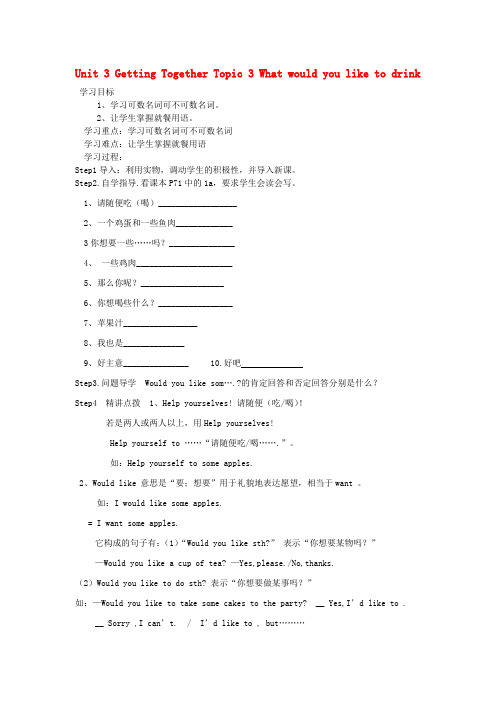
Unit 3 Getting Together Topic 3 What would you like to drink学习目标1、学习可数名词可不可数名词。
2、让学生掌握就餐用语。
学习重点:学习可数名词可不可数名词学习难点:让学生掌握就餐用语学习过程:Step1导入:利用实物,调动学生的积极性,并导入新课。
Step2.自学指导.看课本P71中的1a,要求学生会读会写。
1、请随便吃(喝)__________________2、一个鸡蛋和一些鱼肉_____________3你想要一些……吗?_______________4、一些鸡肉______________________5、那么你呢?___________________6、你想喝些什么?_________________7、苹果汁_________________8、我也是______________9、好主意_______________ 10.好吧Step3.问题导学 Would you like som….?的肯定回答和否定回答分别是什么?Step4 精讲点拨 1、Help yourselves! 请随便(吃/喝)!若是两人或两人以上,用Help yourselves!Help yourself to ……“请随便吃/喝…….”。
如:Help yourself to some apples.2、Would like 意思是“要;想要”用于礼貌地表达愿望,相当于want 。
如:I would like some apples.= I want some apples.它构成的句子有:(1)“Would you like sth?” 表示“你想要某物吗?”—Would you like a cup of tea? —Yes,please./No,thanks.(2)Would you like to do sth? 表示“你想要做某事吗?”如:—Would you like to take some cakes to the party? __ Yes,I’d like to .__ Sorry ,I can’t. / I’d like to , but………Step6.、当堂检测. 单选 ( )1.---Would you like some fish? ---____A. No,thanksB. Give you . C .Sorry ,I can’t.( )2.---What would you like ? -- I would like some ____A. breads and an eggB.bread and eggC. bread and a eggD.bread and eggs( )3.---what about some apple juice ? ---___A. Why not?B. Yes C No . D ,Good idea( )4. --Some water for me,please. ---Me , ____A. andB. also C .too( )5.Help _____ some apples ,please.A. yourself ofB. yourself for C . yourself to6.I'd like some chicken ._______ you ?A. Why not B . What about C. WhatStep7、作业布置.根据汉语完成句子。
仁爱版七年级英语上册Unit 3 Topic 3 C 教案
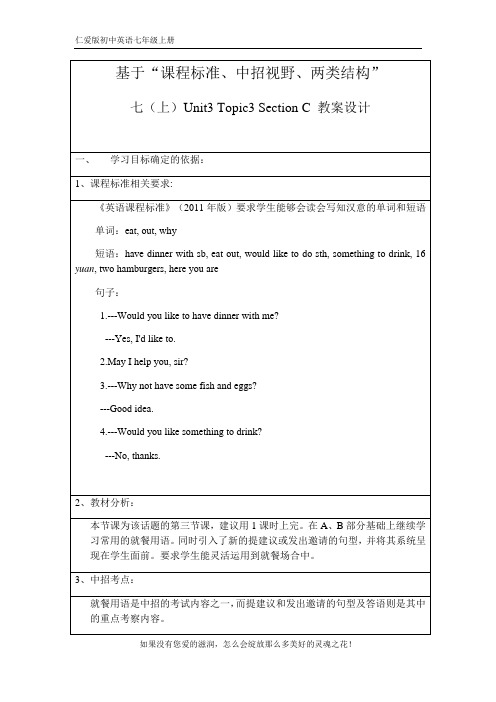
6.3.Let me see意为“让我想一想”
7.Let sb do sth“让某人做某事”
8.eg: Let me help you.
9.
10.
学习目标
教学活动
评价要点
要点归纳
目标4:
能灵活运用就餐和点餐用语,并总结出提建议和发出邀请的句型及答语
自学指导4:
自学内容:课本76页2,3
---Yes. Two _________(glass) of milk, please.
5.---Whatwouldyou like____________(eat)?
---Some bread.
6.---Would you like some___________(fish)
---No,thanks.I'dlikesome _____________(vegetable)
通过让学生自主总结,巩固本课知识,并通过限时训练查漏补缺,及时进行补救练习。
知识小结,要鼓励学生自己做,老师尽量少插手,这有利于加深学生对本课知识的印象。
同时,限时训练要精选题,选题要有梯度性,以达到查漏补缺的目的。对于学生易出错的地方,要让学生学会:“兵教兵”。
将单词归类记忆,并根据发音记单词,有利于提高单词的记忆效率。
学习目 标
教学活动
评价要点
要点归纳
目标2:能读懂1a,并完成相关阅读练习
自学指导2
自学内容:课本75页1a
自学方法:看图片猜测,扫读,精读
自学时间:3分钟
自学要求:能读懂1a, 并完成相关阅读练习
自学检测2
1.Look at the pictures and guess the title of the passages
Unit3Topic3教案2023-2024学年仁爱版七年级英语上册

Unit 3 Topic 3 教案 2023-2024学年仁爱版七年级英语上册一、教材分析本教案为仁爱版七年级英语上册Unit 3 Topic 3。
本节课主要内容围绕日常活动展开,学生通过学习能够掌握动词短语如“play basketball”,“watch TV”等,并能够运用一般现在时表达自己的日常活动。
同时,本节课还涉及到如何用英语进行询问和回答他人的日常活动。
通过对本节课的学习,学生能够更好地运用英语进行简单的交流,提高他们的英语口语能力。
二、核心素养目标本节课旨在培养学生的英语学科核心素养,包括语言能力、文化意识、思维品质和学习能力。
通过学习日常活动动词短语和一般现在时的运用,学生能够提高他们的语言能力,能够用英语描述自己的日常活动。
同时,通过询问和回答他人的日常活动,学生能够培养他们的交流能力和合作意识。
此外,通过学习英语文化背景,学生能够增强文化意识,了解不同国家的日常活动表达方式。
在教学过程中,学生将通过自主学习、合作学习和探究学习的方式,提高他们的学习能力,培养独立思考和解决问题的能力。
三、学习者分析1. 学生已经掌握了哪些相关知识:在开始本节课之前,学生应该已经掌握了基本的英语语法知识,包括动词的时态和语态。
他们也应该能够使用一些日常的英语词汇来描述自己的简单信息和日常活动。
此外,学生应该具备一定的听、说、读、写的能力,能够进行简单的英语交流。
2. 学生的学习兴趣、能力和学习风格:根据对学生的了解,他们对实用性强的英语知识更感兴趣,希望能够用英语进行实际的交流。
在学习能力方面,大部分学生能够跟上教学进度,但程度不同的学生对于新知识的理解和应用能力有所差异。
在学习风格上,一部分学生喜欢通过视觉学习,另一部分学生则更倾向于通过听觉或动手操作来学习。
3. 学生可能遇到的困难和挑战:在本节课的学习中,学生可能会遇到以下困难和挑战:一是对于一般现在时的理解和运用,部分学生可能对此时态的用法混淆不清;二是对于日常活动词汇的掌握,一些学生可能对这些词汇的英文表达不熟悉;三是如何将所学知识运用到实际的交流中,部分学生可能在实际口语交流中感到紧张或不知如何表达。
人教版七年级英语上册Unit 3教案
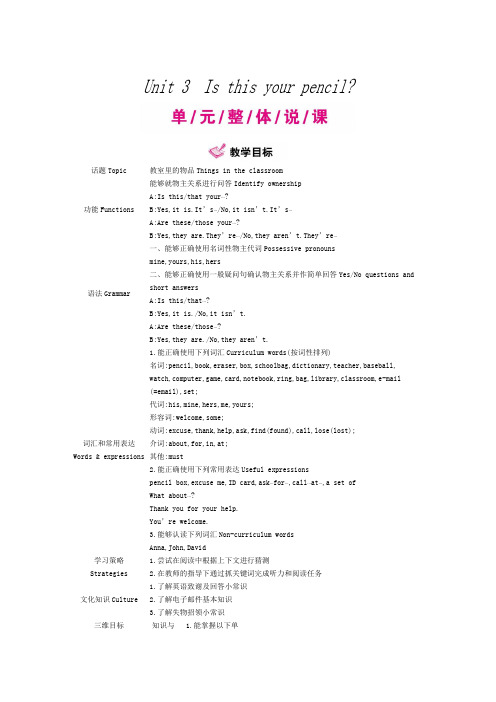
Unit 3 Is this your pencil?话题Topic 教室里的物品Things in the classroom功能Functions 能够就物主关系进行问答Identify ownershipA:Is this/that your …?B:Yes,it is.It’s …/No,it isn’t.It’s …A:Are these/those your …?B:Yes,they are.They’re …/No,they aren’t.They’re …语法Grammar 一、能够正确使用名词性物主代词Possessive pronounsmine,yours,his,hers二、能够正确使用一般疑问句确认物主关系并作简单回答Yes/No questions andshort answersA:Is this/that …?B:Yes,it is./No,it isn’t.A:Are these/those …?B:Yes,they are./No,they aren’t.词汇和常用表达 Words & expressions 1.能正确使用下列词汇Curriculum words(按词性排列)名词:pencil,book,eraser,box,schoolbag,dictionary,teacher,baseball,watch,computer,game,card,notebook,ring,bag,library,classroom,e-mail(=email),set;代词:his,mine,hers,me,yours;形容词:welcome,some;动词:excuse,thank,help,ask,find(found),call,lose(lost);介词:about,for,in,at;其他:must2.能正确使用下列常用表达Useful expressionspencil box,excuse me,ID card,ask …for …,call …at …,a set ofWhat about …?Thank you for your help.You’re welcome.3.能够认读下列词汇Non-curriculum wordsAnna,John,David学习策略Strategies1.尝试在阅读中根据上下文进行猜测2.在教师的指导下通过抓关键词完成听力和阅读任务 文化知识Culture1.了解英语致谢及回答小常识2.了解电子邮件基本知识3.了解失物招领小常识 三维目标 知识与 1.能掌握以下单Three-dimensionaltarget 技能词:pencil,book,eraser,box,schoolbag,dictionary,his,mine,hers, excuse,me,thank,teacher,about,yours,for,help,welcome,baseball,watch,computer,game,card,notebook,ring,bag,in,library,ask,find(found),some,classroom,e-mail(=email),at,call,lose(lost),must,set三维目标Three-dimensionaltarget知识与技能2.熟练掌握单元短语:pencil box,excuse me,what about,thank youfor,computer game,ID card,ask for,call at,a set of3.能掌握以下句型:A:Is this your pencil?B:Yes,it is.It’s mine.A:Are these your books?B:No,they aren’t.They’re hers.A:Thank you for your help.B:You’re welcome.Ask the teacher for it.E-mail me at…4.了解以下语法:名词性物主代词的用法;一般疑问句表示物主关系及其回答。
2014年秋最新仁爱英语七年级上第三单元unit 3 第三话题 topic3 课文知识点梳理及典型例题供参习
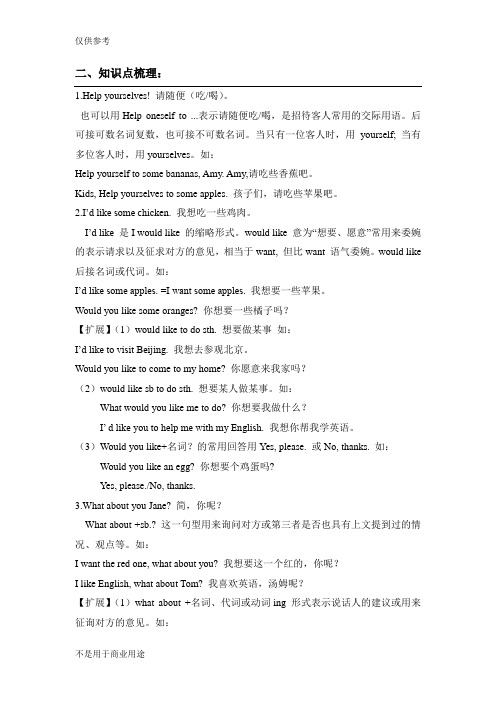
二、知识点梳理:1.Help yourselves! 请随便(吃/喝)。
也可以用Help oneself to ...表示请随便吃/喝,是招待客人常用的交际用语。
后可接可数名词复数,也可接不可数名词。
当只有一位客人时,用yourself; 当有多位客人时,用yourselves。
如:Help yourself to some bananas, Amy. Amy,请吃些香蕉吧。
Kids, Help yourselves to some apples. 孩子们,请吃些苹果吧。
2.I’d like some ch icken. 我想吃一些鸡肉。
I’d like 是I would like 的缩略形式。
would like 意为“想要、愿意”常用来委婉的表示请求以及征求对方的意见,相当于want, 但比want 语气委婉。
would like 后接名词或代词。
如:I’d like some apples. =I want some apples. 我想要一些苹果。
Would you like some oranges? 你想要一些橘子吗?【扩展】(1)would like to do sth. 想要做某事如:I’d like to visit Beijing. 我想去参观北京。
Would you like to come to my home? 你愿意来我家吗?(2)would like sb to do sth. 想要某人做某事。
如:What would you like me to do? 你想要我做什么?I’ d like you to help me with my English. 我想你帮我学英语。
(3)Would you like+名词?的常用回答用Yes, please. 或No, thanks. 如:Would you like an egg? 你想要个鸡蛋吗?Yes, please./No, thanks.3.What about you Jane? 简,你呢?What about +sb.? 这一句型用来询问对方或第三者是否也具有上文提到过的情况、观点等。
七年级英语Unit 3 Topic 3 Would you like something to drink 仁爱版知识精讲

七年级英语Unit 3 Topic 3 Would you like something to drink?仁爱版【本讲教育信息】一. 教学内容:Unit 3 Good Friends. Topic 3 Would you like something to drink?二. 教学重难点:单词:句子讲解:金点剖析:[金点1]Help yourself. 请随便(吃)。
help oneself to…是招待客人常用的交际用语,意思是“请随便吃/用……”。
当有一位客人时,用yourself;多位客人时,用yourselves。
如:Help yourself to some bananas. 请吃些香蕉吧。
Help yourself to some juice. 请随便喝果汁。
Help yourselves to some pizza. 请吃些比萨饼吧。
即时演练:用oneself的适当形式填空1. Help ___________ to some chicken, kids.2. Help ___________ to some juice, Jane.[金点2]I’d like some chicken. 我想吃一些鸡肉。
I’d like是I would like的简写形式,意为“想要……,愿意……”,常用来婉转地表示请求以及征求对方的意见,相当于want,但比want更委婉。
(1)would like后面跟名词或代词。
如:I’d like a cup of tea. = I want a cup of tea. 我想喝一杯茶。
Would you like something to eat? 你想吃点东西吗?(2)would like后跟动词时,用动词不定式形式。
如:I’d like to do some shopping after school. 放学后我想去买东西。
Would you like to come to my home for supper? 你愿意到我家来吃晚饭吗?(3)would like sb. to do sth. 表示“想要某人做某事”。
Module3Unit3学案英语七年级上册

Module 3My schoolUnit 3Language in use学习目标1.复习巩固本模块所学单词、短语和句型。
2.练习巩固there be句型和方位介词(短语)的用法。
3.介绍一下自己的学校。
自主学习学习任务一:根据音标写出对应的英语单词和汉语意思/kəmˈpjuːtə//ˈfɜːnɪtʃə//ˈpɪktʃə/ /ˈθɜːti//ˈfɪfti/ /ˈeɪti//ˈnaɪnti/ /ˈrɪəli//ˈbɪldɪŋ/ /ˈlaɪbrəri/学习任务二:预习活动2看图片,完成短文。
This is a map of our school.(1)the gate is the office building and behind this is the (2).(3)the classroom building is the library. The science building is (4)the dining hall and the(5). And behind the dining hall, the playground and the library there are(6).学习任务三:复习有关学校设施的名词,完成词汇图。
学习任务四:预习Around the world读Around the world中的短文,回答下面的问题。
(1)When must children in most countries around the world go to school?(2)When do the children in the UK go to primary school?(3)When do they go to secondary school?合作探究there be 句型there be句型表示“某处有……”,它表示的不是某人“所有”,而是某地“存在”。
其构成是:肯定句:There is +可数名词数/可数名词…There are +可数名词复数…There an old man near the gate.门口附近有一位老人。
仁爱版七年级英语上册Unit3Topic3WhatwouldyouliketodrinkB优质教案(4)

Topic3WhatwouldyouliketodrinkSectionBI.Materialanalysis本课是第三单元话题三的第二课时,主要活动是1a和3a。
通过康康和迈克尔之间的对话,在复习和巩固关于食物和饮料的词汇的同时,学习谈论一日三餐饮食习惯的用语。
此外,通过看图完成对话,学习顾客在饭店点餐时和服务员对话的常用语。
本课的主要句型有:“Whatdoyouusuallyhaveforbreakfast,Michael?”,“MayItakeyourorder,sir?”等。
在本课中,生词量不多,因此教师应该在SectionA已有的词汇基础上创设情景,让学生在情景对话中自然感知并熟练掌握关于一日三餐饮食习惯及饭店点餐的用语。
II.Teachingaims1.Knowledgeaims能根据已学语音、音标及发音规则,正确朗读下列词汇并在实际的情景对话操练中加以应用:usually,breakfast,lunch,dinner,food,may,take,order ,sir,something,glass,mm;能在情景对话中就一日三餐的饮食习惯及在饭店点餐与服务员对话这两个话题进行交流,如:(1)—Whatdoyouusuallyhaveforbreakfast,Michael?—Iusuallyhavemilkandbreadforbreakfast.(2)—MayItakeyourorder,sir?—Somefishwithvegetablesandabowlofrice,please.在教师的帮助与指引下,通过对话操练、听力训练等活动,能掌握for+breakfast/lunch/dinner的用法。
2.Skillaims能听懂有关一日三餐饮食习惯及饭店点餐等的简单对话;能就一日三餐饮食习惯及饭店点餐话题进行交流;能正确朗读对话,注意语音语调;跟根据图文理解有关就餐的对话与小短文,并根据要求进行学习活动;能根据图文完成有关就餐的对话填空。
仁爱版初中英语七年级上册Unit3 Topic3 Section A公开课教案附反思

公开课教案任教学校:福州教育学院附属中学任课教师:唐晞授课班级:初一8班授课时间:2006年11月23日教材:仁爱版英语七年级上册Unit3 Topic3 Section AI. Teaching books: Project English. Unit3 Topic3 Section AII. Teaching tools: tape recorder, word cards, PowerpointIII. Teaching methods: Teaching as a whole, visual and situational method, and team cooperation.IV. Teaching aims and demands:1. Get familiar with the food vocabulary.2. Learn the use of countable and uncountable nouns.3. Learn how to entertain guests to dinner at home and the response.4. Key sentences:1) What would you like to have/drink? -- I’d like some …2) Would you like some …? -- Yes, please. / No, thanks.V. Teaching Procedures:Step 1 Organization and revision1. Task presentation:●Get familiar with the food vocabulary.●Learn the use of countable and uncountable nouns.●Learn how to entertain guests to dinner at home and the response.2. Listen to the song of ABC. While listening, get students find out food words from the song.3. Check how much students have learnt about the new words:Ss show pictures to partners and ask each other to spell the words.Consolidation: Teacher review new words with the whole class (show pictures).Step 2 Presentation1. Learn countable and uncountable nouns:●Classify the words on the blackboard into countable and uncountable groups:[C]: egg, vegetable, noodle, cake[U]: fish, meat, rice, chicken, tea, milk, water●Play a game:S1: water S2: some water, vegetable S3: some vegetable s, milk S4: somemilk …●Consolidation: Practice those words with sentences:I like …(s) very much. ☺I don’t like …(s) at all. ☹Students work with partners, then make a report.2. Ask and answer:●Review some words with students. (show word cards)●Suppose you invite some classmates to dinner at your home, what should you say? First let us learn some key sentences:1) What would you like to have/drink? -- I’d like some …2) Would you like some …? -- Yes, please. / No, thanks.Ss work in pairs to practice the key sentences, then act out the dialogues.3. Activity 1aListen and understand.Listen again, then read after the tape.Point out some useful expressions:3) What about you, ××? -- I’d like some …4) May I have some …? -- Here you are.5) Help yourselves.4. Activity 2Ss listen to the tape and fill in the blanks. Check the answers.Point out useful expressions: 6) Why not have some …? -- Good idea! Thanks!Step 3 Consolidation & Practice1. Work in groups and study the conversation in activity 1a and activity2. Then work out to make a similar conversation with your group members. (Teacher’s guide: Ss review the key sentences and useful expressions they just learned together before they get to makea new conversation.)2. Act it out in class.Step 4 Project1. Summary: Check out whether Ss finish the tasks or not. (Briefly review the words, sentences and grammar we’ve learnt today.)2. Homework:①Finish your exercise sheet.●Write down the countable nouns and uncountable nouns you learn today.●Make a survey of students in other groups about foods they like and dislike. Thenwrite a new conversation of “Entertaining guests to dinner”.②Make a menu with your group members! (a daily menu, may look up dictionaries for new words, put some beautiful pictures in your menu)课后反思:本堂课基本上完成了预定的教学目标,但细节部分处理不够到位,如应在学生同桌活动及小组活动中给学生更多的操练时间。
仁爱版七年级英语上册Unit3Topic3教案

Topic 3 What would you like to drink?Section AThe main activities are 1a and 3. 本课重点活动是1a和3。
Ⅰ. Teaching aims and demands 教学目标1. (1)Learn some words about food and drink:fish, chicken, rice, drink, juice, milk, water, vegetable, bread, hamburger(2)Learn some other useful words and expressions:yourself/yourselves, help oneself (to), would, about, what about …? all right, for, idea, good idea2. Talk about offering, accepting and refusing:(1)—Would you like some …?—Yes, please.—No, thanks.(2)—What would you like to drink/have?—Apple juice, please.—I’d like some …(3)—Help yourselves!—Thank you.(4)—What about some …?—Good idea.(5)—Milk for me, please.—Me, too.3. Learn countable nouns and uncountable nouns.Ⅱ. Teaching aids 教具图片/实物/录音机/小黑板/彩色粉笔Ⅲ. Five-finger Teaching Plan 五指教学方案Step 1 Review 第一步复习(时间:12分钟)1. (老师出示图片,复习表示食物的单词。
仁爱英语七年级上册Unit3Topic3SectionA教案及测试题

Unit 3 Getting TogetherTopic 3 What would you like to drink ?Section A学习目标:1.知识学习“would like”的运用。
2.方法游戏法、情景法、练习法。
3.情感通过对问答让同学学会有的礼貌询问、问答。
学习重点:Would like的正确运用。
学习难点及突破策略:学习难点:Would like的正确运用。
突破策略:归纳法。
学习流程:【阅读质疑,自主探究】一、走入新课认识更多食品名词:water, vegetable, bread ,hamburger 并将他们分类,完成Part3 。
可数名词:banana 、eggs 、vegetables、hamburgers不可数名词:milk、juice、bread、fish、rice、chicken、water二、阅读提示1:读1a找出下列词汇help yourself ; would like ; what about ; all right ; good idea三、阅读提示2:再读对话1a,试回答下列问题。
1)What would Michael like to have ?2)Would Maria like some eggs ?3) Would Jane like apple juice or milk to drink ?【多元互动合作探究】1.分角色朗读对话1a 并表演。
一、听句子完成填空(2)。
二、教师在黑板上画一个钟,时间指向6:30。
T:Wow! It’s 6: 30. It’s time for dinner. I’m hungry! I’d like some rice and vegetables.What would you like for dinner? Look at the menu, choose and answer.教师先与一对学生示范问答:T: What would you like for dinner?S1: I’d like some fish and beef.S2:I’d like some milk and rice....然后同桌之间进行问答。
七年级英语第一学期导学案答案

七年级英语第一学期导学案答案七上导学案答案unit1topic1sectiona1---5adcddsectionb1---5cddddsectionc1---4daddsectiondⅰ、从b栏中找出a栏各句的应答语。
1.b2.a3.d4.c5.eunit1topic2sectiona1---5bbbca【开拓练】(略)sectionb1---5bacbc【拓展练习】(略)sectionc1---4cbba用适度的词填空题。
2.i3.is4.what5.he6.number7.is8.where9.too10.hersectiond 1---5bccbsectiona1---5cbccbsectionb1---5baabbsectionc1---5bdacbsectiond1---3ccbsectionaunit1topic3unit2topic12 1---6accbba【开拓练】略sectionb1---5dacdbsectionc1---5bacbcsectiond1----5abddbsectiona1---5dbbbcsectionb1---5aadccsectionc1---5bbdabsectiondunit2topic231---3bcaunit2topic3sectiona1---5accacsectionb1---5cccbc选用所给的词完成短文。
short,her,one,nice,its,insectioncsectiond1.b2.d3.e4.f5.c1---6bcccccsectiona1---5cbcccsectionb6.areviewofunits1—2unit3topic14 1---5cbaabsectionc1---5cabcasectiond1---6ababbbunit3topic2sectiona1---5abbba1---5ccaba根据句意和首字母提示完成句子。
仁爱版英语七年级上册 unit 3topic3sectionb教学设计与反思
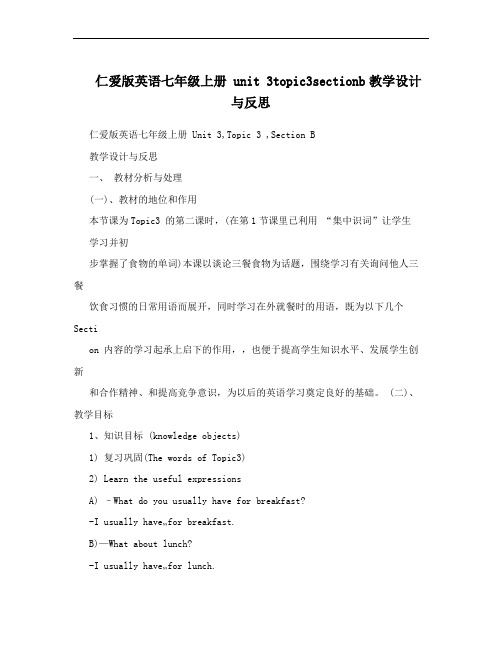
仁爱版英语七年级上册 unit 3topic3sectionb教学设计与反思仁爱版英语七年级上册 Unit 3,Topic 3 ,Section B教学设计与反思一、教材分析与处理(一)、教材的地位和作用本节课为Topic3 的第二课时,(在第1节课里已利用“集中识词”让学生学习并初步掌握了食物的单词)本课以谈论三餐食物为话题,围绕学习有关询问他人三餐饮食习惯的日常用语而展开,同时学习在外就餐时的用语,既为以下几个Section 内容的学习起承上启下的作用,,也便于提高学生知识水平、发展学生创新和合作精神、和提高竞争意识,为以后的英语学习奠定良好的基础。
(二)、教学目标1、知识目标 (knowledge objects)1) 复习巩固(The words of Topic3)2) Learn the useful expressionsA) –What do you usually have for breakfast?-I usually have…for breakfast.B)—What about lunch?-I usually hav e…for lunch.C)-And supper?-I usually have…for lunch.D)May I take your order, sir?E) Wait a moment, please. 2、能力目标1) Using the useful expressions:A) –What do you usually have for breakfast?-I usually have…for breakfast.B)—What about lunch?-I usually have…for lunch.C)-And supper?-I usually have…for lunch.D)May I take your order, sir?E)Wait a moment, please. 3、情感目标1)让学生了解英美国家的饮食习惯2)有明确的学习目的,能认识到学习的目的在于交流,敢于用英语进行表达(三)、教学重点1、不可数名词以及其用法2、The useful expressions of Section B (四)、教学难点1、Get the students to master how to express the food for the three meals2. 三餐中饮食的表达(五)、教学策略:采用多媒体情景教学法、操练法等(六)、学法“授人以鱼,不如授人以渔.” “教是为了不教”(指导学生采用自主学习、合作学习和探究学习的学习策略,让学生通过观察、对比来发现语言的规律,从而达到熟练应用语言的目的。
- 1、下载文档前请自行甄别文档内容的完整性,平台不提供额外的编辑、内容补充、找答案等附加服务。
- 2、"仅部分预览"的文档,不可在线预览部分如存在完整性等问题,可反馈申请退款(可完整预览的文档不适用该条件!)。
- 3、如文档侵犯您的权益,请联系客服反馈,我们会尽快为您处理(人工客服工作时间:9:00-18:30)。
伊川县民办教育七年级英语上学期导学案主备人:申丹(益民学校)审核人:
have? ---I
):__________________________________
Uncountabl
:eg. a box of apples
使用人:使用时间:年月日自我评价:小组评价:教师评价:
____
k
________
_____ _____ _____ __
1.Would you like ______?
two bag of rice B. two bags of rice C. two bag rice
伊川县民办教育七年级英语上学期导学案主备人:申丹(益民学校)审核人:
使用人:使用时间:年月日自我评价:小组评价:教师评价:
伊川县民办教育七年级英语上学期导学案主备人:(学校)审核人:
使用人:使用时间:年月日自我评价:小组评价:教师评价:
伊川县民办教育七年级英语上学期导学案主备人:(学校)审核人:
使用人:使用时间:年月日自我评价:小组评价:教师评价:。
